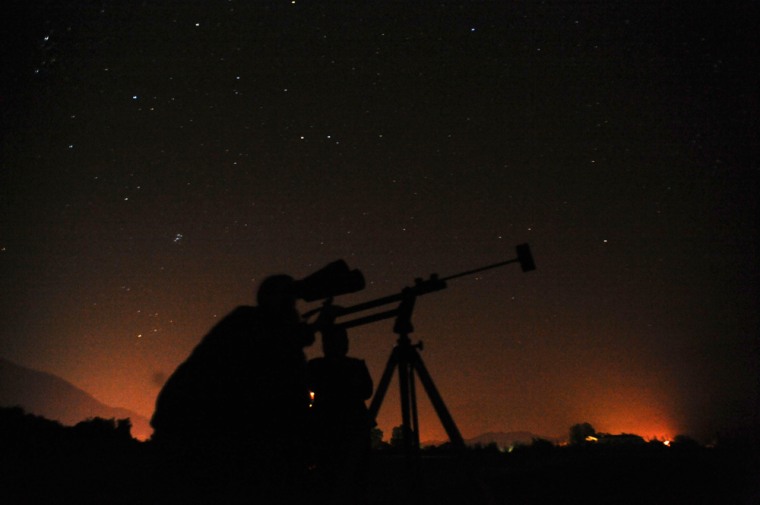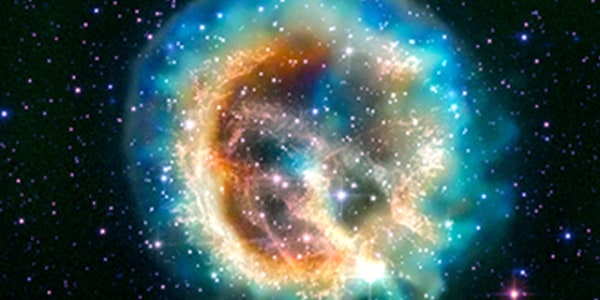For Northern Hemisphere observers, August is usually regarded as "meteor month," with one of the best displays of the year reaching its peak near midmonth.
That display is, of course, the annual Perseid Meteor Shower, beloved by everyone from meteor enthusiasts to summer campers. This year is expected to produce an above average number of "shooting stars" that could offer a rewarding experience to skywatchers around the globe.
There's just one problem: A bright moon will drown out fainter meteors.
The moon will be at last quarter the night of Aug. 13 and it will be at a rather bright waning gibbous phase a night or two earlier, seriously hampering observation of the peak of the Perseids, predicted to occur late on the nights of Aug. 11 and 12.
Moonrise on Aug. 11 comes at around 10:20 p.m., while on Aug. 12 it's around 10:50 p.m. The moon will be hovering below and to the left of the Great Square of Pegasus these nights and not all that far from the constellation Perseus, from where the meteors will appear to emanate (hence the name "Perseid").
Perseus, does not begin to climb high up into the northeast sky until around midnight; by dawn it's nearly overhead. But bright moonlight will flood the sky through most of those two key nights and will certainly play havoc with any serious attempts to observe these meteors.
The Perseids are already around, having been active only in a very weak and scattered form since around July 17, as is typically the case for this annual shower.
But a noticeable upswing in Perseid activity traditionally begins during the second week of August, leading up to their peak. They are typically fast, bright and occasionally leave persistent trains. And every once in a while, a Perseid fireball will blaze forth, bright enough to be quite spectacular and more than capable to attract attention even in bright moonlight.
Unfortunately, because the moon was also at full phase on Aug. 5 it will always be above the horizon during the predawn morning hours (when Perseid viewing is best) in the days leading up to the peak. So even the gradual increase in the shower will be spoiled by moonlight.
The moon arrives at last quarter on Aug. 13 and thereafter its light becomes much less objectionable, but by that time the peak of the display has passed, leaving only a few lingering Perseid stragglers in its wake.
But nonetheless, the 2009 Perseids will be still be worth watching.
Comet crumbs
We know today that these meteors are actually the dross of the Swift-Tuttle comet. Discovered back in 1862, this comet takes approximately 130 years to circle the sun. And in much the same way that the Tempel-Tuttle comet leaves a trail of debris along its orbit to produce the spectacular Leonid Meteors of November, the Swift-Tuttle comet produces a similar debris trail along its orbit to cause the Perseids.
Slideshow 16 photos
Month in Space: July 2009
Indeed, every year during mid-August, when the Earth passes close to the orbit of Swift-Tuttle, the material left behind by the comet from its previous visits, ram into our atmosphere at approximately 37 miles per second and create bright streaks of light in our midsummer night skies.
And according to two meteor researchers, each working independently, 2009 could turn out to be an unusually intense Perseid year.
Mikhail Maslov of Russia has determined that within a matter of several hours on the morning of Aug. 12, the Earth will come close to three trails of dust shed by the Swift-Tuttle comet from three prior visits to the vicinity of the Sun (in 1610, 1737 and 1861). All three encounters will all occur within a roughly 4-hour time frame between 4 and 8 hours, which will be particularly favorable for eastern North America where this interval corresponds to midnight to 4 a.m. ET on Aug. 12; the constellation of Perseus will be gradually climbing the northeast sky during this time frame.
According to Maslov, the Earth will be passing only 87,000 miles from the center of the 1610 trail at 4:07 a.m. ET.
In the absence of moonlight, an observer might see up to 200 meteors per hour around that time, a number that sadly – because of the bright moon – won't in 2009. Overall, though, the Perseids might still put on a good display despite the interfering moonlight, with at least the brighter meteors being visible to patient observers.
Another researcher, Jeremie Vaubaillon of Caltech, used a computer simulation to depict Earth's passage through the Perseids in 2009. Vaubaillon's simulation clearly shows Earth encountering significant meteor activity from about 8 p.m. ET on Aug. 12 through about 2 a.m. ET on Aug. 13, possibly suggesting better than average Perseid activity worldwide for both the late-night hours of Aug. 11 and Aug. 12, local times.
Many years ago, a phone call came into New York's Hayden Planetarium. The caller sounded very concerned after hearing a radio announcement of an upcoming Perseid display and wanted to know if it would be dangerous to stay outdoors on the peak night of the shower (perhaps assuming there was a danger of getting hit by cosmic debris).
These meteoroids, however, are no bigger than sand grains or pebbles, have the consistency of cigar ash and are consumed dozens of miles above our heads. The caller was passed along to the Planetarium's then-Chief Astronomer, Dr. Kenneth L. Franklin (1923-2007).
Franklin quickly allayed any fears by cheerfully commenting that there are only two dangers from watching for Perseid meteors: getting drenched with dew and falling asleep!

